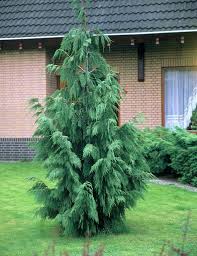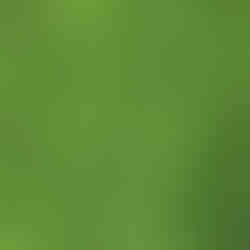Our new ‘Top Trees’ series highlights Martin’s favourite trees under 10 metres for use in urban home landscapes. February is for Conifers!

All noted trees are 10 metres or less in height at maturity, designated for Zone 5 (or under), and are native to, or naturalized within, Ontario.
Medium (10m high x 5m wide)
Korean Fir (Abies koreana)
Slow-growing pyramidal conifer, often used as an accent plant. New shoots are green-grey and mature into pinkish-grey. Most prized for its prolific display of large, upright, purple cones that bring colour to the garden; pine nuts are edible! Suitable for shelterbeds, privacy screens, and/or an outdoor living Christmas tree you can decorate!
Image credits: 1. flickr: Peter GW Jones; 2. wikimedia: Meneerke Bloem; 3. wikimedia: L.Poprawki
Korean Fir is a popular and slow-growing ornamental conifer, often used as an accent plant in home landscapes, parks, Zen and ornamental gardens.
This conifer grows in a pyramidal shape. Shoots are green-grey at first, maturing into a pinkish-grey, with scattered fine pubescence.
Unlike other conifers, the cones are borne on top of the branches and stand upright. It is especially prized for its abundant cone production of large, edible pine nuts that develop even on young trees 1-2m tall.
The koreana species is shorter than other fir trees and will reach a mature height of 10m high by 5m wide (15-30’ tall x 6-15’ wide).
Zone, Growing Conditions & Requirements
Grows in zones 5 to 7; native to South Korea. Grows best in full sun but tolerant to some shade. Generally tolerant of urban conditions.
Highlights & Design Tips
Korean Fir’s most attractive feature is the display of purple cones that appear as the tree begins fruiting, eventually turning tan in colour as the season progresses. The purple cones are a good a way to add colour to your garden. It’s also a desirable option for an outdoor living Christmas tree that you can decorate!
Several varieties of Korean Fir have gained the Royal Horticultural Society’s ‘Award of Garden Merit.’
Sources + more info:
Medium to Large (10m high x 6m wide)
Pendula’ Weeping Nootka False Cypress (Chamaecyparis nootkatensis)
Weeping Nootka Cypress is a slow-growing conifer that features long, graceful, sweeping branches and open foliage similar to that of a cedar tree. Its bluish-green foliage retains its colour throughout the winter, and shaggy Indian-red bark adds an interesting dimension to the landscape. It makes for an excellent feature tree - allow to blend naturally within your garden, or balance with 1-2 finer or coarser trees/shrubs for effective composition.
Image credits: 1. American Conifer Society; 2. wikipedia: MPF; 3. VisionsPictures, Netherlands
Zone, Growing Conditions & Requirements
Zone 5a; native to North America. Fairly low maintenance. Pruning is not necessary but keeps the tree at a manageable height. Grows to an average of 10m (32’) tall at maturity, and is suitable for planting under power lines. Under ideal conditions, it can be expected to live for 70 years or more.
Prefers full sun to partial shade; average to moist conditions, and shouldn't be allowed to dry out. It is not particular as to soil type or pH. It is quite intolerant of urban pollution and benefits from being planted in a relatively sheltered location; street-side plantings are best avoided.
Highlights & Design Tips
The Weeping Nootka Cypress is a very unusual tree and one of our very favourite conifers (it’s also earned a top spot on our “Top Trees of Striking Form” list)! Its average texture blends into the landscape, or can be balanced by the use of 1-2 finer or coarser trees/shrubs for effective composition.
Sources + more info:
Medium (10m high x 5m wide)
Fat Albert’ Colorado Blue Spruce (Picea pungens)
Dense, compact, spire-shaped spruce with large stout branches & long, pointy, silvery-blue needles. A classic favourite for focal points, used in woodlands, Zen & small gardens. Prized by gardeners for refined form, dramatic colour & being extremely hardy & rugged. Showy + colourful in all seasons. Plant behind beds where its distinctive blue foliage acts as a beautiful backdrop.
Image credits: 1. jcbakker.com; 2. Fotosearch.ca; 3. Connon Nurseries
Zone, Growing Conditions & Requirements
Zones 2 to 8. This tree should only be grown in full sunlight. Relatively low maintenance but pruning is advised to remove any dieback. It is very adaptable to both dry and moist growing conditions, but will not tolerate any standing water. It is considered to be drought-tolerant and ideal for xeriscaping. Not particular as to soil type or pH and is able to handle environmental salt. Highly tolerant of urban pollution and suitable for planting under power lines. It grows at a slow rate and, under ideal conditions, can be expected to live for 80 years or more.
Highlights & Design Tips
‘Fat Albert’ has attractive ornamental foliage which emerges silvery blue in spring and remains blue throughout winter. It has a strong central leader and a distinctive and refined pyramidal form. Rough gray bark adds an interesting dimension to the landscape. Plant with barberry, hydrangea, or ornamental grasses. Works well as a windbreak plant or sound barrier.
Sources + more info:
Medium (10m high x 4m wide)
Eastern White Cedar (Thuja occidentalis)
A beloved classic -iconic to North American landscapes. Widely cultivated as ornamental in urban areas and a popular landscaping choice for living fences & privacy screens.
Small and hardy with tapered, often twisted trunk; shiny reddish-brown bark that furrows & peels as it ages. Dense branches provide excellent shelter for wildlife, particularly small birds. The seeds are a preferred food for pine siskins, birds + small mammals.
Image credits: 1. pixabay: Hans Braxmeier; 2. MacPhail Woods 3. The Wild Garden.ca
Zone, Growing Conditions & Requirements
A native to eastern Canada (and much of the north, central and upper northeast U.S.), Eastern White Cedar grows throughout Ontario, usually found in swampy areas where the rock underneath is limestone. Typical lifespan is about 200 years – but trees estimated at over 700 years old have been found in Ontario’s Niagara Escarpment!
Prefers moist soil; tolerates *some* shade; grows in a variety of soils but does not tolerate road salt.
Highlights & Design Tips
Because of its small size, the Eastern White Cedar is a popular landscaping choice for living fences and privacy screens, although some shelter or protection from drying winter winds is recommended.
Wildlife/Other Uses
Cedar’s dense branches provide smaller birds with excellent protection and cover from winter winds and predators. The seeds are a preferred food for pine siskins and are eaten by grosbeaks, redpolls, crossbills, and other species of birds and small mammals; white-tailed deer eat the twigs during winter.
Cedar is a sacred, medicinal plant to Native Americans; its' common name, Arborvitae, means ‘tree of life.’ Used for medicinal, household and ceremonial purposes.
Cedar can be used for stream-side or wetland rehabilitation and in reforestation on wet sites.
Exceptionally high in vitamin C; essential oils are released when you scratch the glands with your thumbnail.
On a warm summer’s day “the trees will release fenchone and both alpha and beta-thujone into the immediate environment. These chemicals are strong cardiac muscle stimulants and will help the heart in its pumping function…White cedar also produces camphene and camphor, which are broncholdilators and improve the breathing of all those suffering from chronic lung problems.” -Diana Beresford-Kroeger
Sources + more info:

























